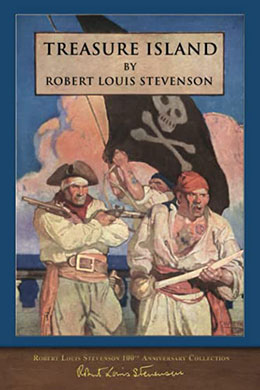 Treasure Island, by Robert Louis Stevenson (1850–1894), first published serially under the title, The Sea Cook, has enormously impacted me since I first read it as an adolescent. Written, as the original subtitle had it, “for boys,” it has been the hallmark of all pirate tales, and many other adventure stories since it first appeared. It was not, curiously, highly successful as a serialized story, but when it appeared with a new title in book format, it established Stevenson’s high reputation.
Treasure Island, by Robert Louis Stevenson (1850–1894), first published serially under the title, The Sea Cook, has enormously impacted me since I first read it as an adolescent. Written, as the original subtitle had it, “for boys,” it has been the hallmark of all pirate tales, and many other adventure stories since it first appeared. It was not, curiously, highly successful as a serialized story, but when it appeared with a new title in book format, it established Stevenson’s high reputation.
For those who don’t know the story—if such is possible—it concerns the buried treasure of Pirate Captain Flint on a remote island (the location carefully not cited) which his old crew is determined by hell or high water to recover. Simultaneously, two British gentlemen, Dr. Livesey and Squire Trelawney, are equally determined to get it. They are aided and abetted by young Jim Hawkins, who lives the adventure of a lifetime and is the essential narrator of the story. So it is Jim’s book in deed and word.
I cannot attest to the accuracy of all its rich nautical terminology, or ways of a ship, but suffice it to say it reads with the presumption of great knowledge. That goes for all the verbal wordplay, which is as dynamic as it is captivating. Indeed, the sheer energy of the book is quite breathtaking. It is truly a non-stop adventure.

by Robert Louis Stevenson, published by Charles Scribner’s Sons, 1911
But while the boy, Jim, is the book’s protagonist, the portrayal of Long John Silver is the great triumph of the book. To describe him as charismatic is but half his fascination. A wonderful talker, sly, evil, a liar, generous, funny, clever, he is altogether wonderful to behold, a one-legged man who (metaphorically) out-races all the other characters in the book. It’s not that Jim is a poor or dull character, it’s that Long John Silver is a brilliant creation. When I first read the book—and again, just recently—it is he who gives the story its greatness.
That said the other characters are wonderfully presented, Captain Billy Bones, Blind Pew, and many more are all quite fine. And if you can get hold of the old Scribner edition of the book—it has been reprinted—with illustrations by N. C. Wyeth, you’ll be even more rewarded. For years I had a reproduction of Wyeth’s portrait of a desperate Blind Pew over my writing desk. Oh, if only I could write a book and character like that!

by Robert Louis Stevenson, published by Charles Scribner’s Sons, 1911
But there is a secret in the book which is right there in the open for all to find. The treasure that the pirates are after is stolen loot. The pirates are murderous scoundrels. Their only claim to the treasure is that they took it by theft and murder.
That said, Dr. Livesey and Squire Trelawny, the English gentlemen who go after it, have no claim to it either. They are not interested in giving it back to those who lost it even though there is a record (in the story) of when and where it was stolen. What does Trelawney say? “We’ll have favorable winds, a quick passage, and not the least difficulty in finding the [treasure], and money to eat—to roll in—to play duck and drake with ever after.” Indeed, the gentlemen will get the treasure via their own theft and murder.
In the end, it is Long John Silver, alone among the pirates, who escapes to his freedom. Stevenson was not about to hang his glorious creation. No fool he.
Read Treasure Island.
You’ll be singing:
Fifteen men on the Dead Man’s Chest
Yo-ho-ho and a bottle of rum!
1 thought on “Yo-ho-ho and a bottle of rum”
I was going through your “Story behind the Story” blog series again, and realized there is one more book that was left out. “Strange Happenings: Five Tales of Transformation”. Please write a blog post about that book and also what specific message and moral you were trying to convey in the story “Bored Tom” and “The Shoemaker and old scratch”. Thank you.